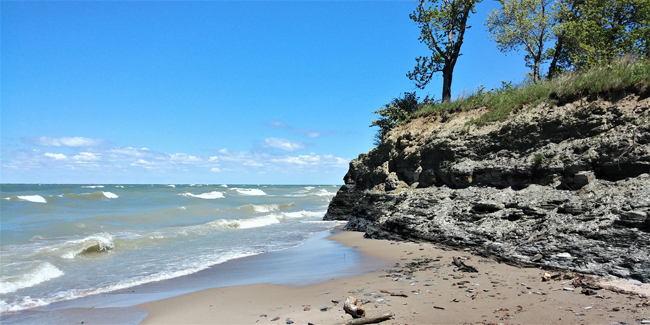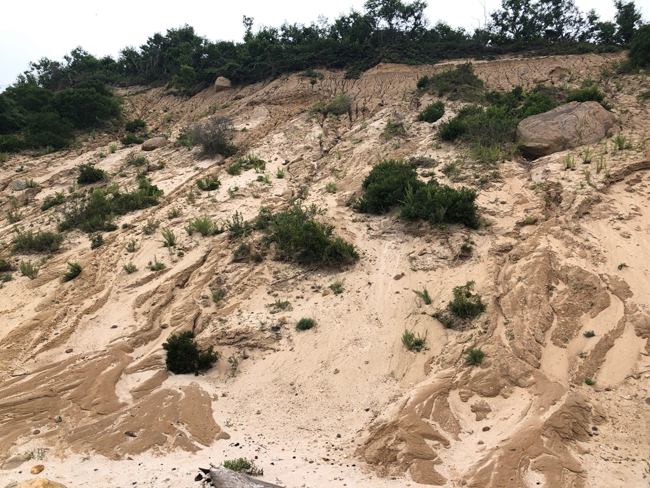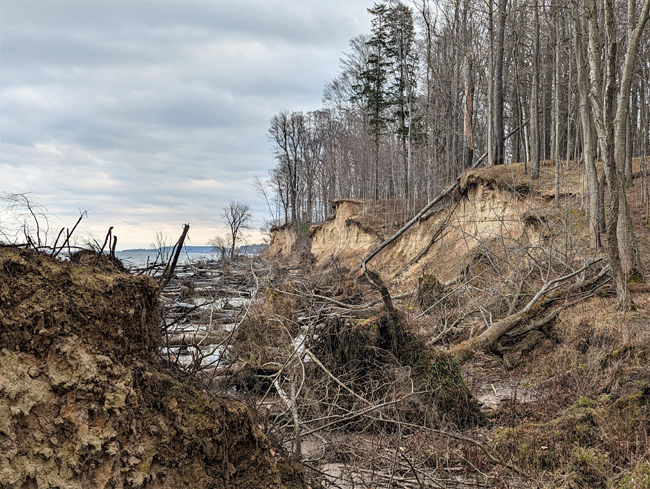
Bedrock bluffs in Angola along Lake Erie topped with glacial lake sand and gravel. Credit: NYSG/Roy Widrig
New York Sea Grant Provides Virtual, In-Person Assistance, New Guide to NY’s Coastal Bluffs
Contacts:
Kathleen Fallon, Marine Coastal Processes and Hazards Specialist, E: kmf228@cornell.edu, P: 631-632-8730
Roy Widrig, Great Lakes Coastal Processes and Hazards Specialist, E: rlw294@cornell.edu, P: 315-312-3042
Kara Lynn Dunn, Great Lakes Publicist, E: karalynn@gisco.net, P: 315-465-7578
Paul C. Focazio, NYSG Communications Manager, E: Paul.Focazio@stonybrook.edu, P: 631-632-6910
Ithaca, NY, April 18, 2023 - Extension help is available to Great Lakes and Long Island property owners seeing damage to their shoreline washing away with the waves, wind, freeze-thaw, ice, storm surge or flooding.
New York Sea Grant (NYSG) Coastal Processes and Hazards Specialists Roy Widrig and Kathleen Fallon, Ph.D. are available for virtual and in-person assistance.
“Spring is prime time for property owners to assess winter damage and consider appropriate actions for their specific issues, whether those issues impact shoreline habitat or erosion that may encroach on properties or affect the structural integrity of those properties,” said Widrig.
Widrig and Fallon have recently published an “Erosion and Recession of New York’s Coastal Bluffs” guide to bluff formation, erosion processes acting on coastal bluffs, mass movements of bluffs, and how to monitor and report bluff erosion. The guide, which includes an insert for tracking erosion on a property, is free to download at www.nyseagrant.org/theblufflet.
“Coastal erosion on Long Island or in the Great Lakes region can impact development and infrastructure as well as natural habitats. Sometimes there is a slow wearing away of the shoreline; other times, storm surge can undercut a bluff, causing instability and eventual and sudden collapse,” said Fallon.

Unconsolidated sediments ranging in grain sizes in the bluffs of Long Island. Credit: NYSG/Kathleen Fallon
Widrig helps property owners in New York’s Great Lakes region. Fallon assists those on Long Island. They apply their expertise to identify nature-based or structural ways to mitigate the erosion that impacts shoreline habitat, and encroaches on or affects the structural integrity of coastal properties.
The NYSG specialists also provide information on various state and local shoreline project permitting requirements.
Great Lakes regional property assessment options are accessed online or contact Widrig at 315-312-3042, rlw294@cornell.edu.
Long Island property owners can reach Fallon at 631-632-8730, kmf228@cornell.edu.
New York Sea Grant has additional guides on shoreline erosion mitigation and adaptation practices, planting native plants species that absorb and filter stormwater and stabilize sand dunes, bioengineering measures, and installing breakwalls and other hard structures.

Rapidly eroding glacial lake sands in Wayne County. Credit: NYSG/Roy Widrig
More Info: New York Sea Grant
New York Sea Grant (NYSG), a cooperative program of Cornell University
and the State University of New York (SUNY), is one of 34 university-based
programs under the National Oceanic and Atmospheric Administration’s
National Sea Grant College Program.
Since 1971, NYSG has represented a statewide network of integrated
research, education and extension services promoting coastal community
economic vitality, environmental sustainability and citizen awareness
and understanding about the State’s marine and Great Lakes resources.
Through NYSG’s efforts, the combined talents of university scientists
and extension specialists help develop and transfer science-based
information to many coastal user groups—businesses and industries,
federal, state and local government decision-makers and agency managers,
educators, the media and the interested public.
The program maintains Great Lakes offices at Cornell University, SUNY
Buffalo, SUNY Oswego and the Wayne County Cooperative Extension office
in Newark. In the State's marine waters, NYSG has offices at Stony Brook
University in Long Island, Brooklyn College and Cornell Cooperative
Extension in NYC and Kingston in the Hudson Valley.
For updates on Sea Grant activities: www.nyseagrant.org has RSS, Facebook, Twitter, Instagram, and YouTube links. NYSG offers a free e-list sign up via www.nyseagrant.org/nycoastlines for its flagship publication, NY Coastlines/Currents, which is published quarterly.